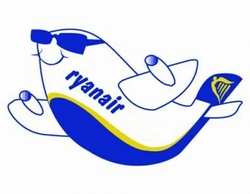Developing A Passenger Freight System That Eliminates Seats
Entirely
ANN April 1st Special Edition:
With improvements such as winglets and engine technology having
pushed airliner efficiency near theoretical limits, and passengers
still demanding cheaper seats, aircraft designers are looking into
radical changes in the way we fly. Airbus has announced a
partnership with Ryaniar, the Irish low-cost carrier, to design
future airliners with features which could cut the cost of airline
travel by at least half.

The shape and size of airliner cabins face design limits based
on the shape and size of the human body, which led Ryanair CEO
Michael O'Leary last year to propose such innovations as fewer
restrooms on short-hop flights for passengers willing to simply use
the restrooms in the terminal before departure, making room for
more seats in the same cabin size. But it was O'Leary's proposal to
develop saddles for passengers, allowing a near-standing posture
during flights in exchange for tickets as cheap as $19, that really
caught the eye of Airbus officials.
Airbus CEO Tom Enders says of O'Leary, "The guy is a visionary.
Airline passengers like to complain on blogs about Ryanair's crappy
service and sardine-can ethic, but every time regulators agree to
reductions in comfort to save a buck, passengers are only to happy
to move to the cheaper alternative. It's clear what they really
want is not always what they say they want."
In a Memorandum of Understanding (MOU) signed today in Swords,
County Dublin, Ireland, the two companies have agreed to
collaborate on a new cabin design for a future variant of the
Airbus A320 which will borrow heavily from both the pre-boarding
system employed by Southwest Airlines and techniques used to
optimize the shipping of cargo. Passengers will arrive at the
terminal, be paired with a willing partner, and be assisted by gate
agents in interlocking their bodies in small, plexiglas cubes
measuring approximately 17.5 cubic feet, or about 0.5 cubic
meters.
Once in place and briefed on emergency procedures, the
passengers will have their cubes closed and connected to fresh air
ventilation systems, and stacked on pallets to await the arrival of
their planes. The modified A320 aircraft will have no seats, but
instead be fitted with clamshell doors which open approximately one
third of the cabin ceiling. Upon the plane's arrival at the gate,
the roof will be opened, and specialized cranes will move and lower
pallets of passenger cubes into the aircraft, where they'll slide
fore-and-aft on tracks to allow filling the front and rear of the
cabin first, then the center, before the overhead doors are
closed.
The idea was reportedly inspired by circus performers Arevik and
Tatevik Seyranyan, who will be retained as consultants on the
project. The sisters will also be featured prominently in
promotional materials, TV ads, and a planned series of in-cube
safety videos.
O'Leary says of the system, "We've determined that using this
new passenger accommodation modality, an A320 could hold as many as
950 passengers, essentially giving us seat-mile costs well below
those of the A380, and with access to far more airports. The
estimated elapsed time from a plane's arrival at a gate to its next
departure, including deplaning and re-boarding passengers, could be
cut to as little as little as six minutes. And best of all, since
no one can move once on board, we could eliminate not just one
lavatory, but all of them. We also suspect expectations for
expensive frills such as in-flight wifi and other cabin
entertainment to be greatly reduced."

Enders admits there are some issues to be resolved. "We're not
sure what happens in the event someone gets airsickness on the top
row of crates. Holes designed to allow passengers to talk between
rows might be a problem in such a case. We'll also need to develop
certain new emergency procedures. Without traditional exits, for
example, we believe it might be necessary in a water landing to
instruct pilots on how to execute a barrel roll with the ceiling
open in order to free the cubes before impact. We have determined
that pallets of cubes will float once released."
There is already talk of how the new passenger accommodation
technology might allow joint ventures with cargo companies,
possibly making airport terminals as we know them obsolete. The
growing relationship between Ryanair and Airbus is also prompting
discussion of a consulting deal in which O'Leary may assist Airbus
parent EADS in bringing new aircraft development projects in
on-time and under-budget.
Airbus says a prototype of the new plane, tentatively given the
codename A320knee-oh, could be ready for flight testing by the
second quarter of 2013. In order to meet a goal previously
announced by EADS to diversify into areas in which the US Dollar is
the prevailing currency, the cubes are being prototyped under a
contract with US partner Acme Aquarium of Dayton, Ohio.
 Aero-News: Quote of the Day (04.28.25)
Aero-News: Quote of the Day (04.28.25) ANN's Daily Aero-Term (04.28.25): Decision Altitude (DA)
ANN's Daily Aero-Term (04.28.25): Decision Altitude (DA) ANN's Daily Aero-Linx (04.28.25)
ANN's Daily Aero-Linx (04.28.25) Airborne-Flight Training 04.24.25: GA Refocused, Seminole/Epic, WestJet v TFWP
Airborne-Flight Training 04.24.25: GA Refocused, Seminole/Epic, WestJet v TFWP Aero-News: Quote of the Day (04.29.25)
Aero-News: Quote of the Day (04.29.25)




